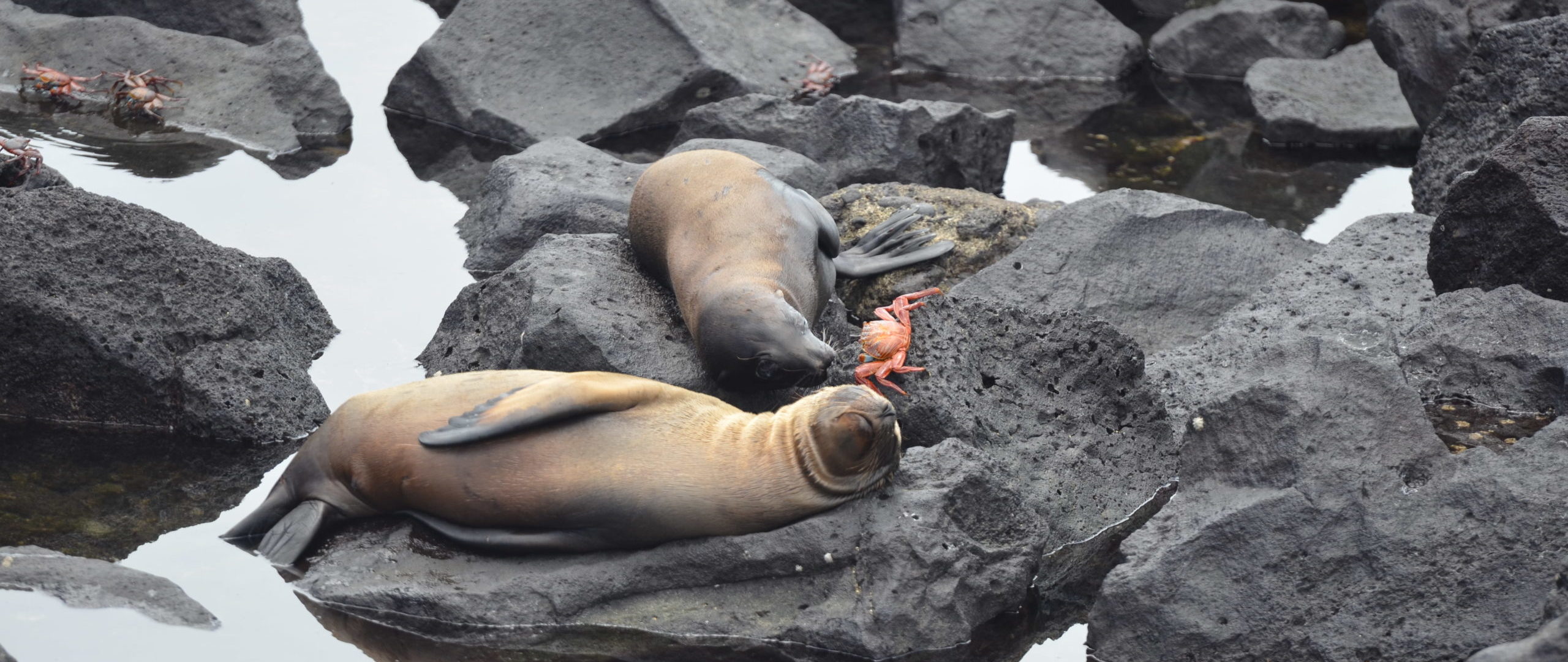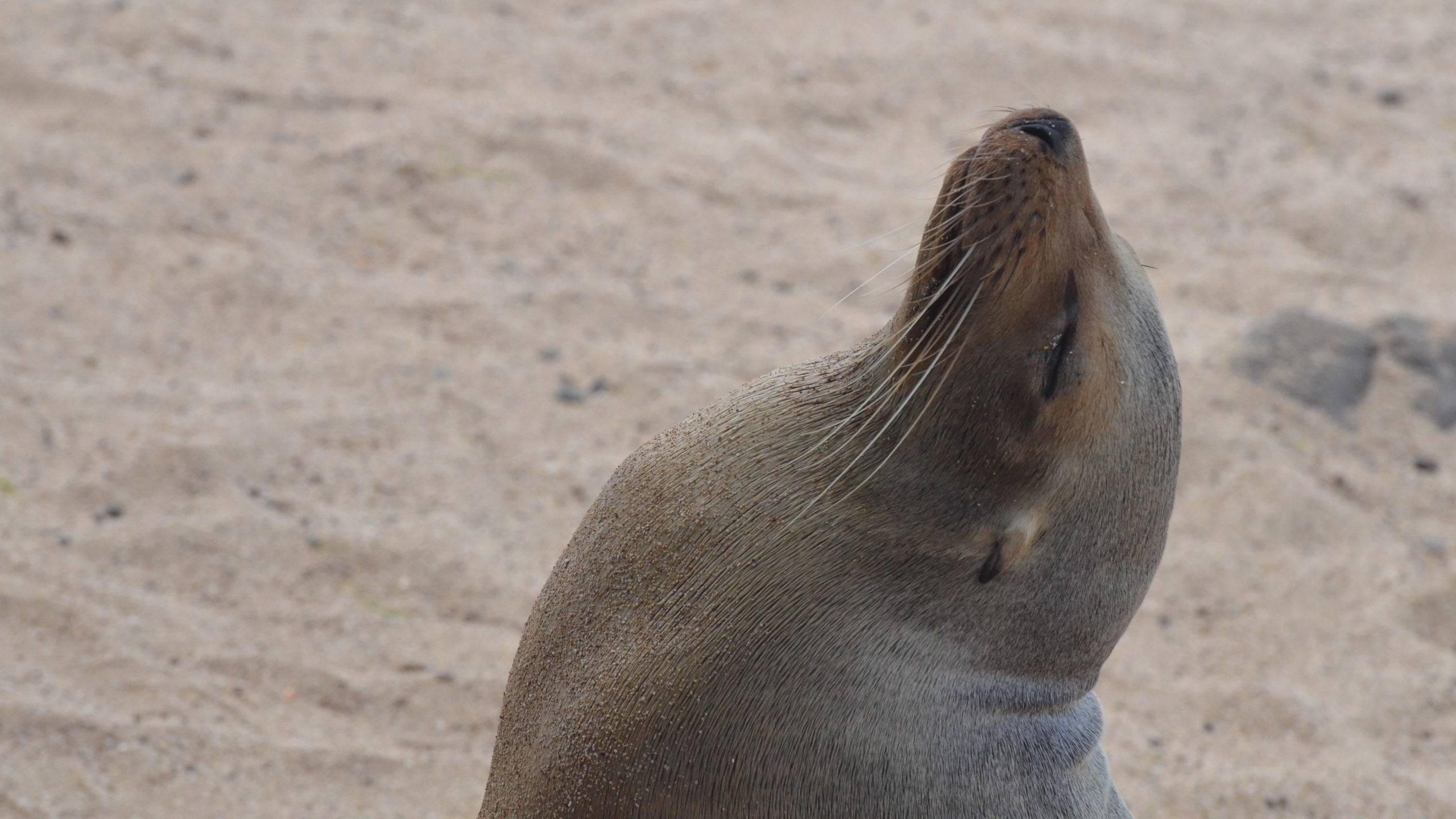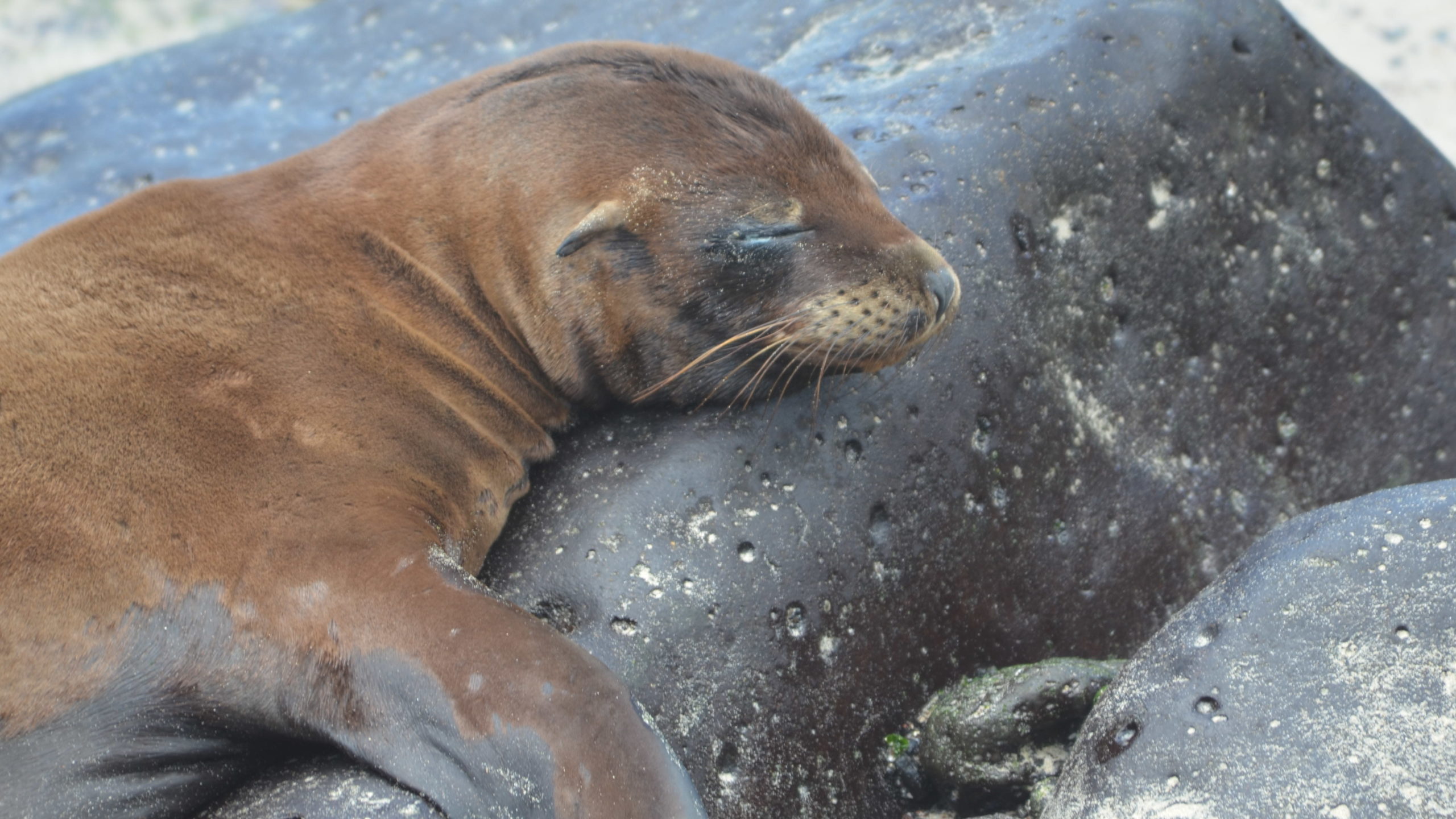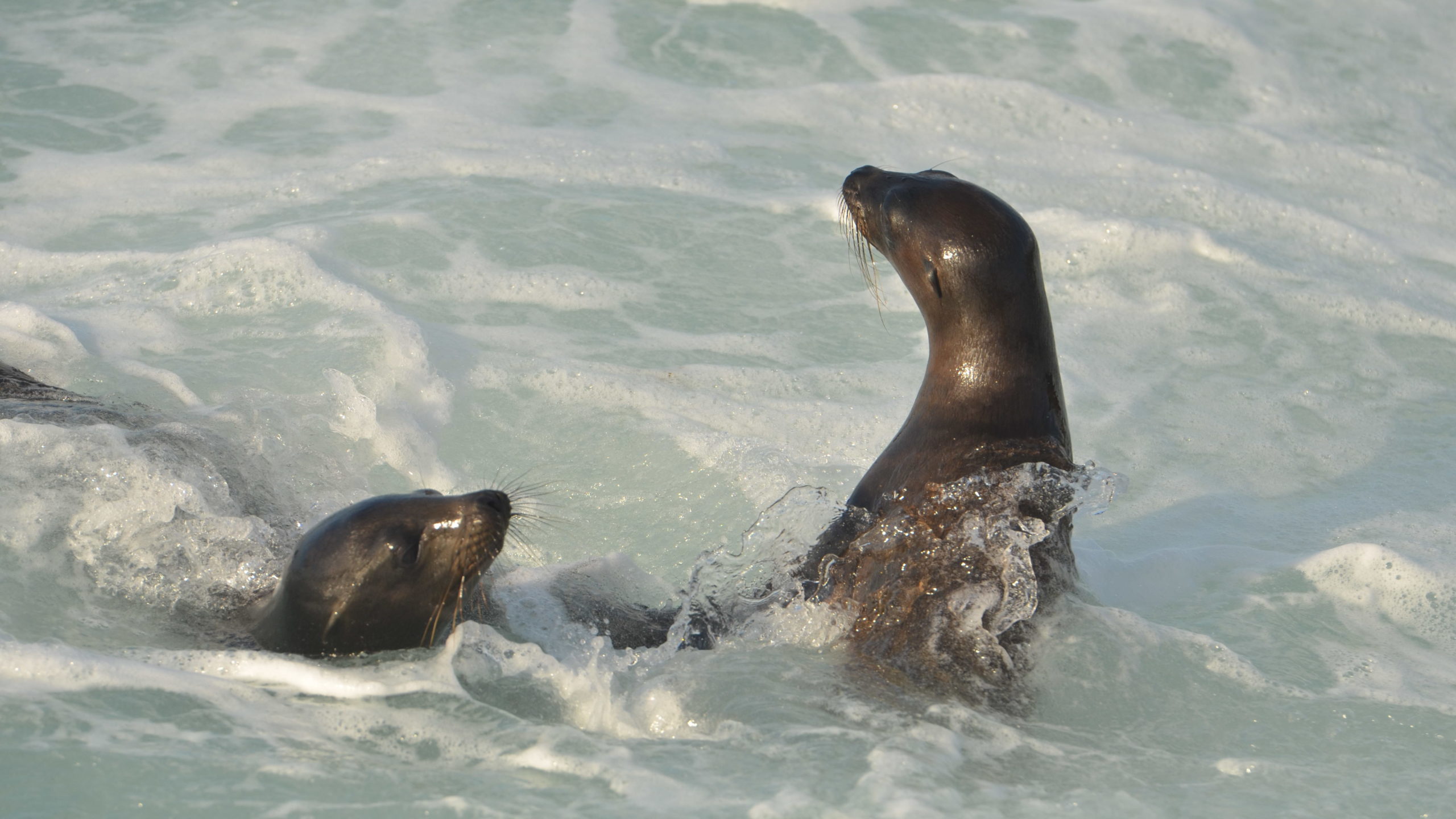August 8, 2025
Galápagos Sea Lions: The Playful Icons of the Islands

If there’s one animal guaranteed to make you smile during your Galápagos adventure, it’s the Galápagos sea lion (Zalophus wollebaeki). These playful marine mammals are the most abundant in the islands and often the first to greet visitors as they step ashore. Endemic to the archipelago, sea lions can be found everywhere, from basking on sandy beaches to performing graceful spins in turquoise waters. As part of the Galápagos National Park and Marine Reserve, they are strictly protected, so it’s important to know how to enjoy these encounters responsibly.
About this species
Are They Lions or Seals? Despite their name, Galápagos sea lions aren’t lions, and they’re definitely not seals. They belong to the otariid family, which means they have external ear flaps and can rotate their hind flippers forward. This unique feature gives them their characteristic, almost dog-like way of moving on land.
For years, scientists believed they were a subspecies of the California sea lion, but DNA studies revealed that Galápagos sea lions became a distinct species around 2 million years ago.
These charismatic mammals typically live 15–20 years, although males often have shorter lifespans due to intense competition and territorial battles. Males can weigh up to 250 kg (550 lbs) and measure over 2.5 meters (8 feet) long, while females are much smaller, averaging 100 kg (220 lbs). Social by nature, sea lions live in colonies, often organized around a dominant male who defends his harem and territory from rivals.

What Makes Them Special
Galápagos sea lions aren’t just adorable, they’re fascinating animals with unique behaviors and adaptations that make them one of the most iconic species in the islands:
- Social structure: Sea lions are highly social and live in colonies often organized around a dominant male who defends his harem of females. Bachelor males, on the other hand, form their own resting groups nearby.
- Breeding: Females typically give birth to a single pup after an 11-month pregnancy. Pups remain with their mothers for more than a year, learning to swim, hunt, and survive in the ocean under her watchful eye.
- Playfulness: These marine mammals are the most curious and interactive species in the Galápagos. In the water, they love performing spins, blowing bubbles, and even mimicking snorkelers! Their confidence and playfulness make for some of the most memorable wildlife encounters you’ll ever have.
- Diet: Galápagos sea lions are carnivores, feasting mainly on fish and squid. In the water, they’re agile and fast, using their streamlined bodies to chase prey with incredible precision.
Where You’ll See Them
Galápagos sea lions are undoubtedly among the top highlights when it comes to experiencing unique wildlife up close in the Galápagos. While these playful marine mammals can be found on almost every island in the archipelago, a few spots are particularly renowned for their large colonies. These locations offer incredible opportunities for encounters:
- San Cristóbal: Home to massive colonies, sometimes more than 300 individuals on a single beach.
- Isabela: Great for snorkeling encounters.
- Española: Known for playful pups and stunning beaches.
Choosing a land-based tour offers incredible opportunities to see them up close, not just during beach walks and snorkeling sessions, but sometimes even right outside your hotel or along the boardwalks, where these curious animals love to rest. Staying longer on land gives you more chances to observe their behavior in different settings, both on shore and in the water. It’s just one more reason why land tours are a winning choice in the Galápagos. Read more about why land-based tours are the best option here.

When to See Pups
Although you can see sea lion pups any time of year, the peak season is August to November, when nurseries are bustling with young ones learning to swim. Pups nurse for up to a year, and their mothers often return from long foraging trips to feed them. During this time, you’ll find them close to shore, forming playful “nurseries” where they splash, chase, and practice their swimming skills in shallow waters, a heartwarming sight for any visitor.
Galápagos Sea Lion Encounters
One of the highlights of any Galápagos trip is seeing these animals up close. These charismatic creatures are everywhere, from sandy beaches where they bask like sunbathers, to rocky shorelines where they seem to “pose” for photos.
Slip into the water, and the real adventure begins. While snorkeling, sea lions often glide gracefully past or spin playfully around you, sometimes even interacting with sea turtles, spinning and nudging them in playful underwater games. Their curiosity makes every interaction feel like a once-in-a-lifetime moment.
On land, don’t be surprised to find them sprawled across benches, snoozing along boardwalks, or sneaking into local fish markets! They’re as comfortable in human spaces as they are in their ocean playground.
If sea lions are at the top of your Galápagos wish list, consider these tours that offer unforgettable encounters. For those craving maximum time in the water, the 10-Day SUP & Kayak Adventure is perfect for marine enthusiasts who want extended paddling and snorkeling experiences. Families looking to bond through shared discovery will love the 8-Day Family Tour, packed with fun and educational activities for all ages, from beach adventures to wildlife encounters, making it an ideal choice for creating lasting memories together. For a balanced experience with plenty of opportunities to relax on beaches and snorkel alongside these charismatic creatures, the 10-Day Land-Based Tour is an excellent choice.

Rules for Safe & Respectful Encounters
Sea lions are friendly, but they’re still wild animals. Here’s what to keep in mind:
✔ Keep your distance: At least 2 meters (6 feet).
✔ Let them approach you: Never chase or block their path.
✔ Stay calm in the water: Sudden movements can startle them.
✔ Do not touch or feed: This disrupts their natural behavior.
✔ Watch for dominant males: They can be territorial, especially during breeding season.
Why They Matter
Sea lions aren’t just cute, they’re an essential part of the Galápagos ecosystem. As top predators, they help regulate populations of sardines, squid, crustaceans, and other prey, which in turn maintains balance throughout the marine food web. According to the Galápagos Science Center, the Galápagos Sea Lion weighs in at the top of the trophic chain, and “protecting their populations will have a wider umbrella effect to all other species lower down in the chain”.
Protecting their shores and underwater habitats is essential, not just for the sea lions themselves, but for the integrity of the entire archipelago’s ecosystem. Viewing sea lions up close is a rare privilege, and when approached responsibly, it not only creates unforgettable experiences but also supports conservation efforts that ripple through the ecosystem.
Want to swim with these playful locals? Plan your Galápagos adventure today!
